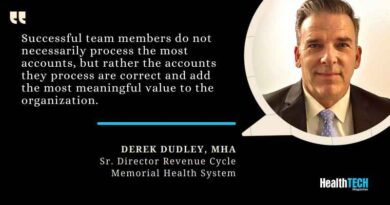The Changing Tide in Revenue Cycle – From Collecting to Protecting
By Christopher Ault, CRO, Cooper University Health Care
The “Cycle” Endpoint Has Been Extended
Search for a good definition of “Revenue Cycle” in healthcare and you will likely find something that reads: “The processes related to the intake, capture, billing, and collection of reimbursement for care provided.” It used to be that when a claim was paid in full, the revenue cycle team’s job was complete. That’s no longer the case.
In recent years, the “cycle,” as we once knew it, now extends well beyond resolution of an outstanding balance. I call this shift ‘the transition from collecting to protecting.’ Revenue cycle teams must now be equipped to manage and protect payments from audit and recoupment for another 18 months or more. With the [seemingly] continued growth in the volume of post-payment audit activity, simply collecting revenue is no longer sufficient.
To avoid the delay in paper mail processing throughout the health system, we allow team members to scan correspondence and send to a centralized inbox reducing delays.
The Challenge to Keep Up
Payers and their contracted third parties use broad-based algorithms to query and audit large quantities of cases. These audits often challenge reimbursement elements- from documentation to billing to medical necessity. And while the algorithms target a variety of possible reasons for recoupment, they can also vary in the way they’re delivered, the timeframes permitted to respond, and the documentation and detail requested.
Retrospective payer audits present three distinct challenges for providers:
1) Asymmetrical Risk
Many commercial payers engage the help of third parties for retrospective auditing whose fees are often contingency-based. This contingency fee model provides incentive for the auditors to overwhelm providers with volumes ofaudit activity..
The sheer volume requests makes it more difficult for providers to spend adequate time and resources to construct robust and nuanced appeals justifying the payments. This increases the likelihood that a certain amount will “fall through the cracks” and inadequately be defended as proper payment for services.
For payers and their auditing contractors, there is no downside to trying and failing. Whereas on the provider side of the equation, nothing is gained and everything can be lost. Even when we’re successful, it costs us money and resources to retain what was rightfully ours in the first place.
2) Procedural Hurdles
Often, audits will stipulate that if the requested documentation is not received within a certain timeframe or is incomplete, recoupment will be automatically applied to the account.
Worse still, all audit requests are not sent, received, and processed the same way. For large health systems especially, this presents all sorts of hurdles: Letters can be sent to different departments at different locations, mailroom processing can take weeks, e-mails could go to a team member who recently left, and so on.
3) Medical Necessity in Hindsight
Retrospecitive challenges to medical necessity makes for an uneven playing field between providers and payers. When patients present to the hospital, providers treat them using all of the experience, education, skill, and information that they have in the moment and at the time the patient is in front of them and in need of care.
Payers retrospectively make medical necessity determinations in light of the ultimate outcome of the case. This is inherently unfair and should not be allowed. Medical necessity standards, as they apply to reimbursement and level of care, should not be subject to retrospective review if both parties agree in real time that the care being provided is appropriate.
Long-Reaching Impacts
For providers, defending these numerous audit requests requires multidisciplinary input, investment in resources, and a centralized team of SMEs who can facilitate and defend every type of scenario. This work is costly to providers and if not done skillfully can present serious financial harm to providers’ budgets and bottom lines.
Revenue recognition, budgeting, and statistical forecasting often relies on historical claim activity. This, by default, a certain baseline of audit and recoupment activity.. As more and more prior-period visits are subject to increased retrospective audit activity, the outcome of those cases need to be factored collaboratively and in real-time with internal departments to avoid unfavorable variances down the road.
Preparing a Proper Defense
With the rising costs of care, it makes sense to expect that payers and plan sponsors will continue to use retrospective audit as a strategy to reduce payments to providers. With this in mind, providers should be strategizing and building out their ‘revenue defense’ strategies if they haven’t already. Below are some strategies we have deployed at Cooper:
1) Track and Trend
Deploy technology to track all audit activity centrally. Pay attention to categorization of audit types and the grouping of payers and subcontractors. You will want to slice this data differently depending the context of use. Share this data with all internal stakeholders so that they understand what is happening in the aftermath of patient care and claim payment. Those internal stakeholders should be (at a minimum): Managed Care, Finance, CDI, Coding, Billing, and UM/Case Management.
2) Centralize & Educate
Enssure that the team responsible for managing third-party audits is robust and centralized, with SME’s identified for each type of potential appeal. Besides being multidisciplinary and diverse in skillset, the team should be educated in all pertinent contract language, laws, and payer-driven policies that may apply to this function. Recognizing inappropriate, disallowed, or illegal audits at first notice can save your team hours of work on the back end.
3) Line Up External Help
Some audit appeals require external assistance- either because of resource constraints or the nuance of a particular defense that is required. Be strategic about who you contract with for which types of appeals and ensure they are operational well in advance of an audit.
4) Organized Communication
To avoid the delay in paper mail processing throughout the health system, we allow team members to scan correspondence and send to a centralized inbox reducing delays.. This accelerates the timeline to start a response and reduces the likelihood of getting penalized for missing a deadline.
These are just a few suggestions and are, by no means, a complete list of the things providers must consider when establishing an efficient, well-resourced and scalable defense strategy. Clearly, this is not a sensible or efficient way for our nation’s health care system to work. Yet, providers must acknowledge this reality and dedicate the effort to address it, ensure they are paid for the great care they provide, and protect their bottom line.



